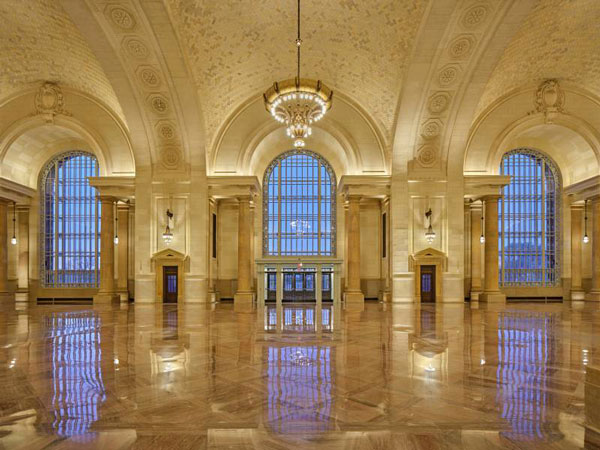The hulking ruin that used to greet international travelers near the Ambassador Bridge between Windsor and Detroit has been transformed by Ford Motor Co. into a visionary center for the development of new mobility technologies.
The former Michigan Central Station, now known as The Station, is part of a 30-acre ‚Äúinnovation district‚Äù comprising once derelict buildings on downtown Detroit‚Äôs west side, properly known as Corktown.¬Ý
The building, once owned by the Ambassador Bridge, has been brought back to its 1913 Beaux Arts grandeur that was once the tallest train station in the world, designed by Warren & Wetmore¬Ýand¬ÝReed¬Ýand¬ÝStem, who also designed New York‚Äôs Grand Central Terminal.

The station’s inauguration in early June is a major Detroit event where the massive building with 18 floors has been thrown open to the public in a festive like atmosphere and where a first night concert featured hometown musical greats Diana Ross and Jack White.
The former blighted almost 500,000-square-foot building had long been an international embarrassment but was saved with the almost $1 billion restoration, which began in 2018 under the direction of Quinn Evans and PAU architects and contractors Christman Brinker.
Project manager Ron Staley says he likes to compare the renovation to Paris’s Notre Dame Cathedral after the church’s partial destruction in 2019.
“They had a fire and we had an abandonment,” noting the voluminous damage that had beset a once proud building that saw thousands of travelers arrive and depart every day.
The terminal was last used by Amtrak in 1988 but was abandoned, left exposed to the elements and numerous vandals that raided any valuable fixtures and surfaces. Staley said restorers were “lucky” work commenced when it did.
“Given another three to five years, there likely would have been a structural collapse.”
The restoration was beset by two challenges – massive flooding and structural decay. There were half-a-million gallons of water in the basement and six feet of ice in the corners of the attic above the one-time waiting room now called the Grand Hall.

“We had to get the building aired out so we could determine the extent of the structural deterioration,” Staley said.
Ice, encountered in late spring when crews first scoped the building, had formed from leaks after copper in the roof was stolen. The building had eight different roofs and “every one had failed, all of the downspouts and roof conductors for those were either stolen or had broken because the building wasn’t heated.”
It took a year to pump out the water and seal to prevent further rain penetration.
The water in turn caused structural steel deterioration.

“Likewise in areas that were exposed to continuous moisture such as roof decks and certain floor deck areas, the steel literally just disappeared,” Staley said.
It took another year to identify the locations and work with engineers to fix.
After those problems were solved, COVID-19 entered the picture and “we had to work around that,” Staley said.
New roofs, structural steel, HVAC and electrical were added. Then interior plaster work began, which took another two years. At its peak, more than 500 were employed at the station. But hundreds more skilled trades and artisans were involved on and off site including fabricating new exterior stone in a town in central Michigan.
Some of the unique subprojects included the 20,000-square-foot Grand Hall’s three vaulted domes with almost 30,000 Guastavino tiles. The tiles had to be tapped for looseness, the vast majority were intact, and cleaned. And 8.6 miles of mortar was cut out and replaced to secure them. That took a year-and-a-half.
Moreover, the tiles were besmirched by moisture and coal soot from the former railway locomotives.
“We used some decorative coatings to mirror the original finish without damaging the tile,” Staley said. “Because otherwise we would have destroyed the tile trying to get the soot off. Other than that, it’s a light detergent Рjust a masonry cleaner Рand the workers would take a small squirter and squirt a section of them and then rinse and clean off.”
Meanwhile parts of the stone walls had “just rotted away” due to water damage and decades of freeze-thaw.
Remarkably, the restorers were able to reopen an abandoned quarry in southern Indiana where the original stone came from, and 600 tons of limestone were reclaimed. One tradesman spent 428 hours hand carving a single capital column replica for the building’s main entrance.
The building’s offices above were “very Spartan,” Staley said.
Finishes like marble in the central corridor had been destroyed by the weather or stolen.
“The only part that was really salvageable was a terrazzo finished floor in the corridor. For all the abuse the rest of the building took those were all restored.”











Congratulations to Ford and all involved for not allowing Michigan Central Station to go the way of Penn Station.